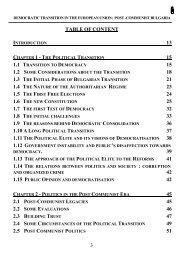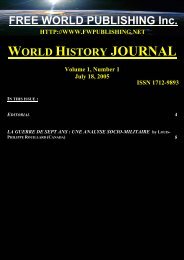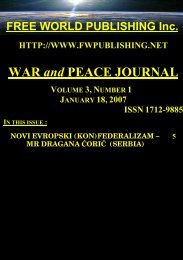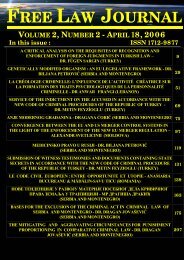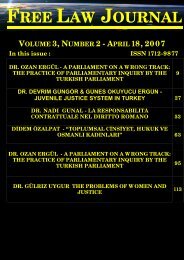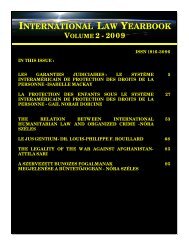Free_Law_Journal-Vol.. - Free World Publishing Inc.
Free_Law_Journal-Vol.. - Free World Publishing Inc.
Free_Law_Journal-Vol.. - Free World Publishing Inc.
Create successful ePaper yourself
Turn your PDF publications into a flip-book with our unique Google optimized e-Paper software.
FREE LAW JOURNAL - VOLUME 1, NUMBER 1 (18 JULY 2005)<br />
If the plaintiff invokes an action with the same reference to the same contentious issue before the court<br />
once again because he was cast in the first action or the first action has expired despite that no decision is<br />
given, praetor rejects this demand (denegatio actionis). Praetor, gives this decision spontaneously 29 .<br />
In personal actions which derived from the authority of a magistrate and have formulas with in factum<br />
concepta and also in real actions, praetor does not turn definite judgement to account by himself<br />
spontaneously. Bis de eadem re ne sit actio principle, can be taken into account during the action by an<br />
exception called exceptio rei iudicatae vel in iudicium deductae –exceptio about definite judgement or<br />
concluded joinder of issue 30 . To use this exceptio, only the conclusion of joinder of issue of the action is<br />
sufficient 31 . The obligation which is the subject of the action is accepted to be removed by the conclusion<br />
of joinder of issue of the first action 32 .<br />
In the formulary system of Roman procedural law, to apply bis de eadem re ne sit actio principle, the first<br />
action and the subsequent action must be the same. This is called eadem res 33 . According to Roman law<br />
eadem res can only exist, if the subject of the demand (idem corpus), the legal characteristics of the<br />
demand (idem ius), the legal causes of the demand (eadem causa petendi) and the parties of the demand<br />
(eadem condicio personarum) are same in the first and the subsequent actions 34 . Sameness of the parties<br />
forms the subjective similarity; Sameness of the subject forms the objective similarity. Objective and<br />
subjective similarities must be together at the same time so that eadem res exists and exception of definite<br />
29 Arangio-Ruiz, V.: Storia del Diritto Romano, 7. Ed. con Note Aggiunte, Naples, 1957, p. 163; Betti, E.; Istitutizione di<br />
Diritto Romano, V. I, Parte Generale, Padova, 1960, p. 601 sq.; Tahiroglu/ Erdogmus, (Procedure), p. 28; Wenger, p. 177-8.<br />
30 “Gai, 3, 181; Unde fit, ut si legitimo iudicio debitum petiero, postea de eo ipso iure agere non possim, quia inutiliter intendo.<br />
Dari mihi oportere, quia litis contestatione dari oportere desiit, aliter atque si imperio continenti iudicio egerim; tunc enim<br />
nihilo minus obligatio durat, et ideo ipse iure postea agere possum, sed debeo per exceptionem rei iudicatae vel in iudicium<br />
deductae summoveri. quae autem legitima sint iudicia et quae imperio continentia sequenti commentario referemus; Hence if I<br />
bring a legally authorized action for the collection of a debt, I can not afterwards, under strict rule of law, sue a second time, as<br />
the statement that the defendant is required to pay me something will be without effect; for the reason that by joinder of issue,<br />
he ceases to be obliged to make payment. The case is different if in the first place I brought an action derived from the authority<br />
of a magistrate, for then the obligation will still continue to exist and therefore, by the strict rule of law, I can bring another<br />
action; but I can be barred by an exception grounded on a previous judgement, or on a former joinder of issue. We shall explain<br />
in a subsequent Commentary what actions are authorized by law and what are derived from the authority of a magistrate.<br />
Wenger, p. 179; Buckland, W. W.; A Text-Book of Roman law from Augustus to Justinian, Cambridge, 1932, p. 697; Excepti<br />
rei iudicatae, not only merely bars the same action between the same parties, but also enforces the principle, as between parties<br />
bound by the judgement.<br />
31 Roby, p. 262; Tahiroglu/ Erdogmus, (Procedure), p. 28;.<br />
32 Tahiroglu/ Erdogmus, (Matters), p. 195; Wenger, p. 120; D. 44, 2, 12, Paul. 70 ad ed.: Cum quaeritur, haecexceptio noceat<br />
nec ne, Inspiciendum est, an idem corpus sit; D. 44, 2, 3, Ulp. 75 ad ed.: Iulianus libro tertio digestorum respondit exceptionem<br />
rei iudicatae obstare, quotiens eadem quaestio inter easdem personas revocatur. The plaintiff can be barred by the exception<br />
when he brings the same contentious issue before the court, suing the same person. These texts show that, when eadem res<br />
exists, bis de eadem re ne sit actio principle is applied and in such a situation, the second action can be hindered by an exceptio<br />
rei iudicatae. But, of course the type of action must be kept in mind. Some other Roman law texts mentioning this topic can be<br />
given as example; D. 44, 2, 14 pr., Paul. 70 ad ed.: et an eadem causa petendi et eadem condicio Personarum: quae nisi omnia<br />
concurrunt, alia res est. Idem corpus in hac ecte optione non utique omni pristina qualitate vel quantitate servata, nulla<br />
diectione deminutioneve facta, sed pinguius pro communi utilitate accipitur.<br />
D. 44, 2, 27, Ner. 7 membr.: Cum de hoc, an eadem res est, quaeritur, haec spectanda sunt personae, id ipsum de quo agitur,<br />
causa proxima actionis. Nec iam interest, qua ratione, quis eam causam actionis competere sibi existimasset, perinde ac si<br />
quis, posteaquam contra eum iudicatum esset, nova instrumenta causae repperisset.<br />
33 Berger, A.; Encyclopedic Dictionary of Roman <strong>Law</strong>, Philadelphia, 1968, p. 132; Eadem res means the same object. This<br />
expression is used to explain bis de eadem re ne sit actio principle. It rests on the notion that an issue once decided must not be<br />
raised again.<br />
34 D. 44, 2, 27; D. 44, 2, 12-13.<br />
GOKCE TURKOGLU-OZDEMIR - “BIS DE EADEM RE NE SIT ACTIO” PRINCIPLE IN THE FORMULARY SYSTEM OF ROMAN LAW OF PROCEDURE 145






